Abstract
This study was designed to define the conditions that will consistently produce stress ulcers following the systemic infusion of live E. coli (1.0-1.6 X 10(10) organisms/kg/hr). Using gold-filled oxygen microelectrodes and the in vivo gastric chamber model in dogs, the authors found that the intracellular oxygen tension of the superficial gastric epithelium declined during sepsis despite maintenance of total gastric blood flow. This hypoxia persisted for the three-hour experiment when normal saline bathed the gastric surface (n = 6). Adding 1-mM taurocholate (Tc) (n = 6) or 80-mM hydrochloric acid (HCl) (n = 6) to the gastric chamber improved the cellular hypoxia induced by sepsis, and no ulcers were produced. However, addition of physiologic concentrations of bile in acid (1-mM Tc in 80-mM HCl) produced widespread ulceration of the mucosa within 30 minutes in nine of ten dogs. These experiments demonstrate that epithelial hypoxia induced by sepsis predisposes the gastric mucosa to ulcerate in the presence of physiologic concentrations of topical acid and bile.
Full text
PDF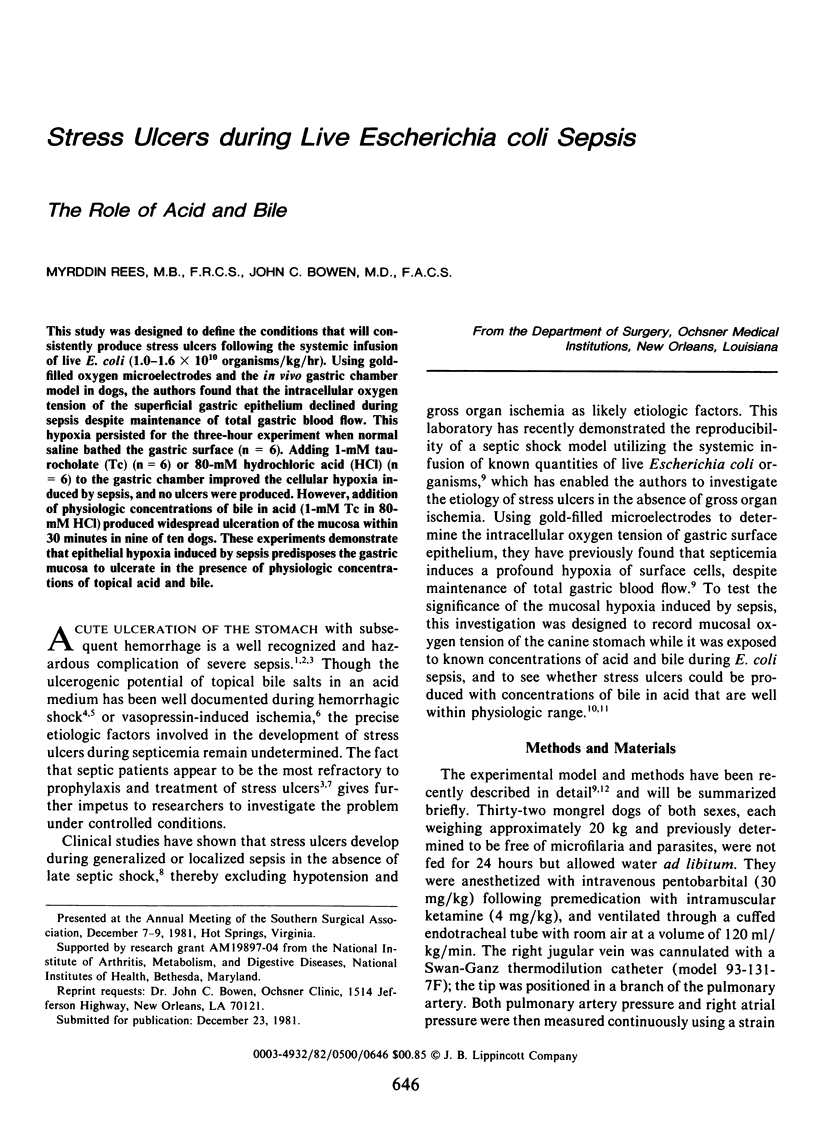
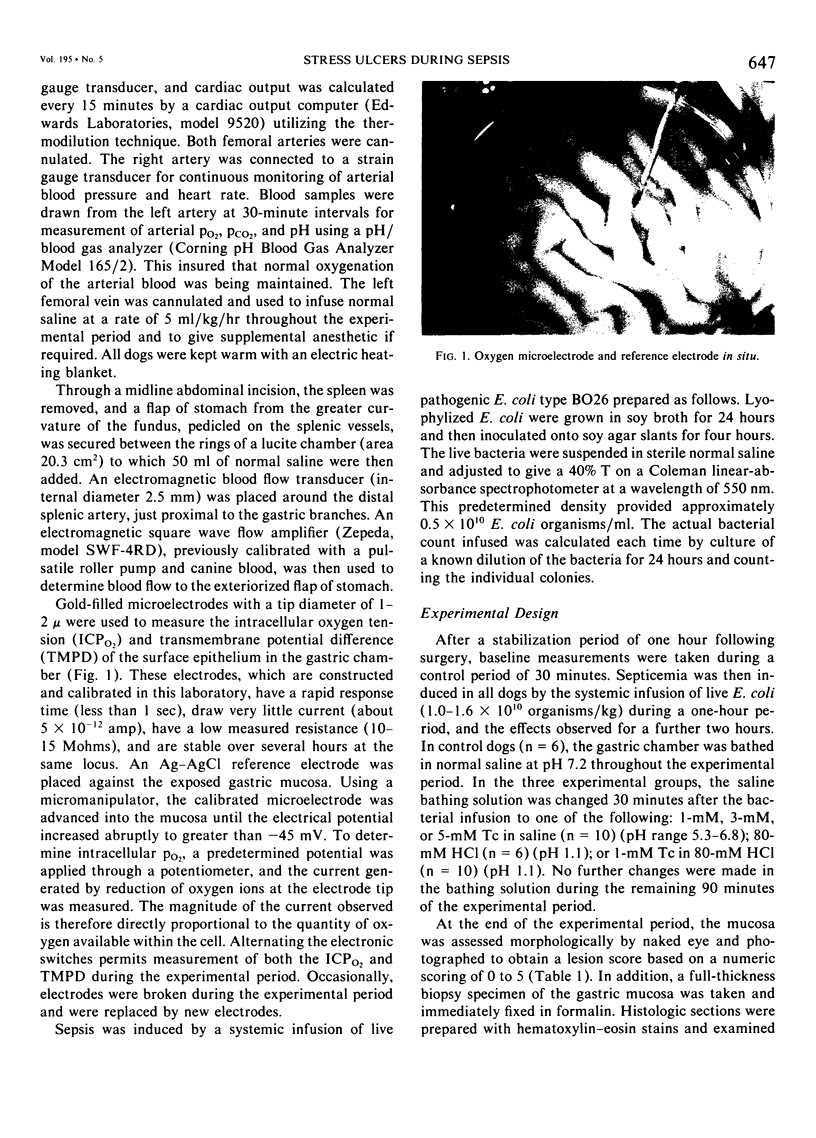
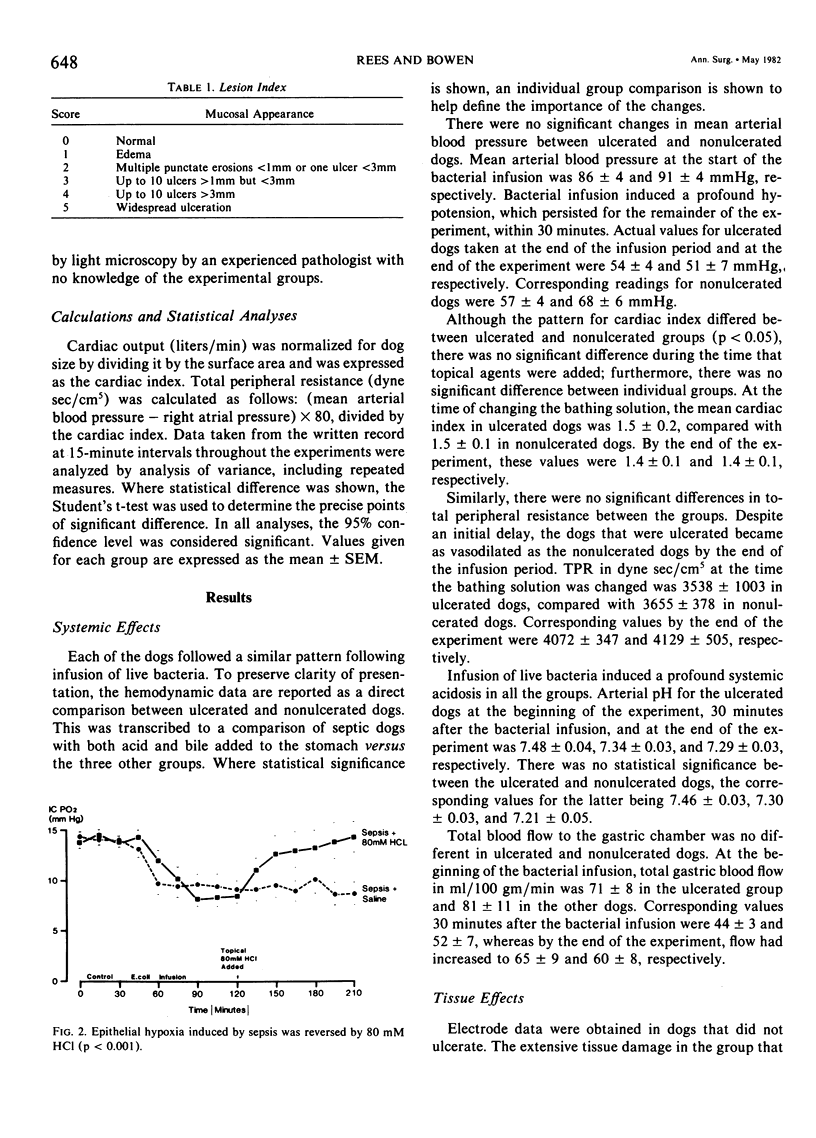
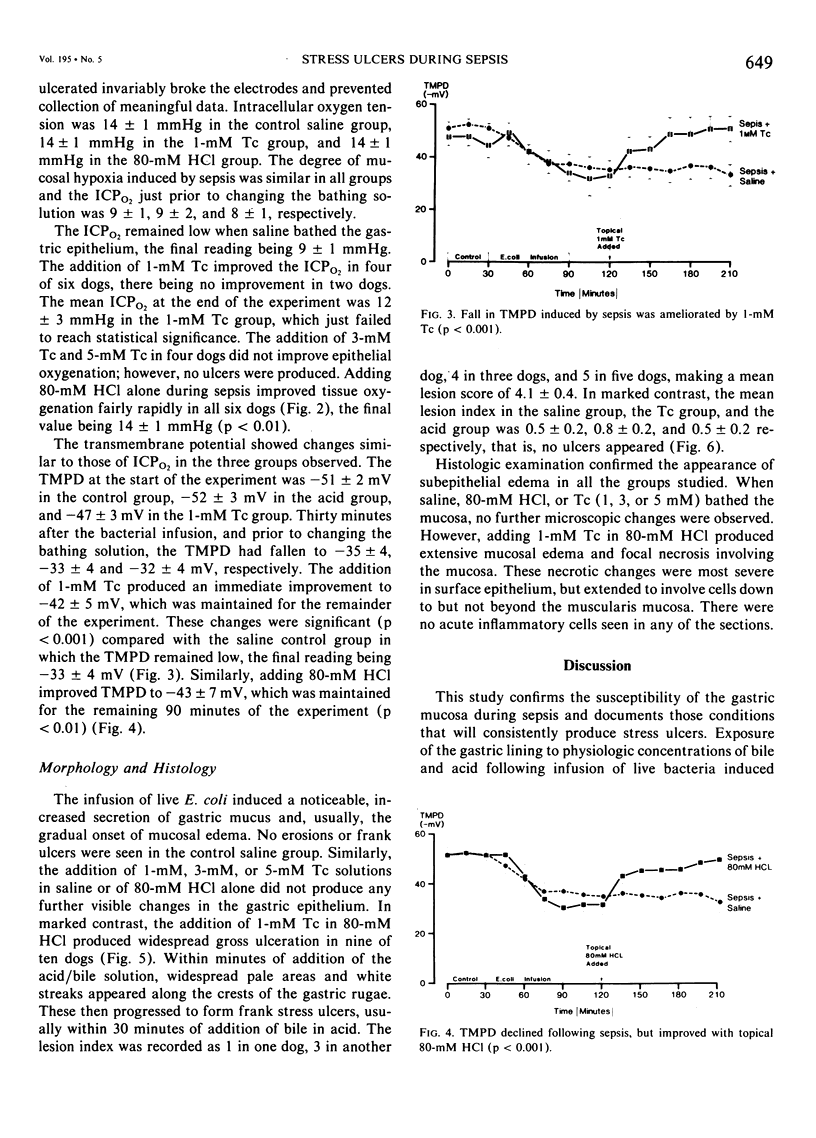
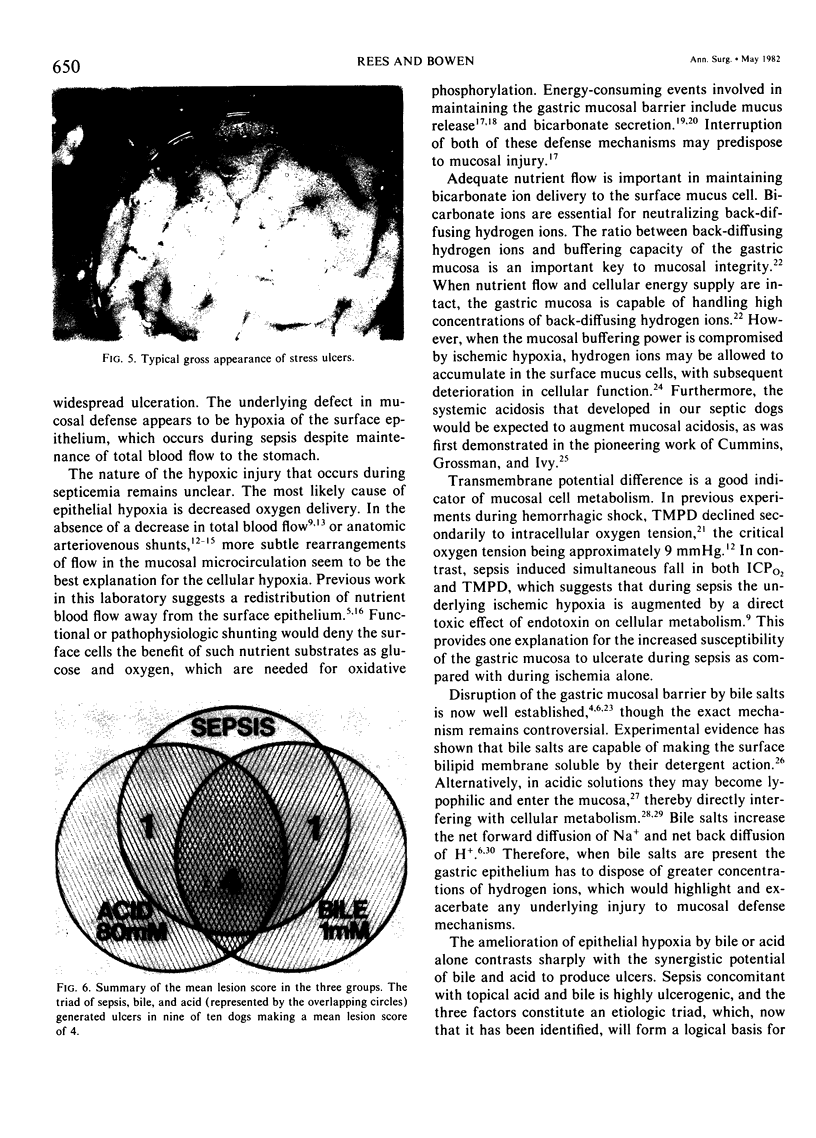
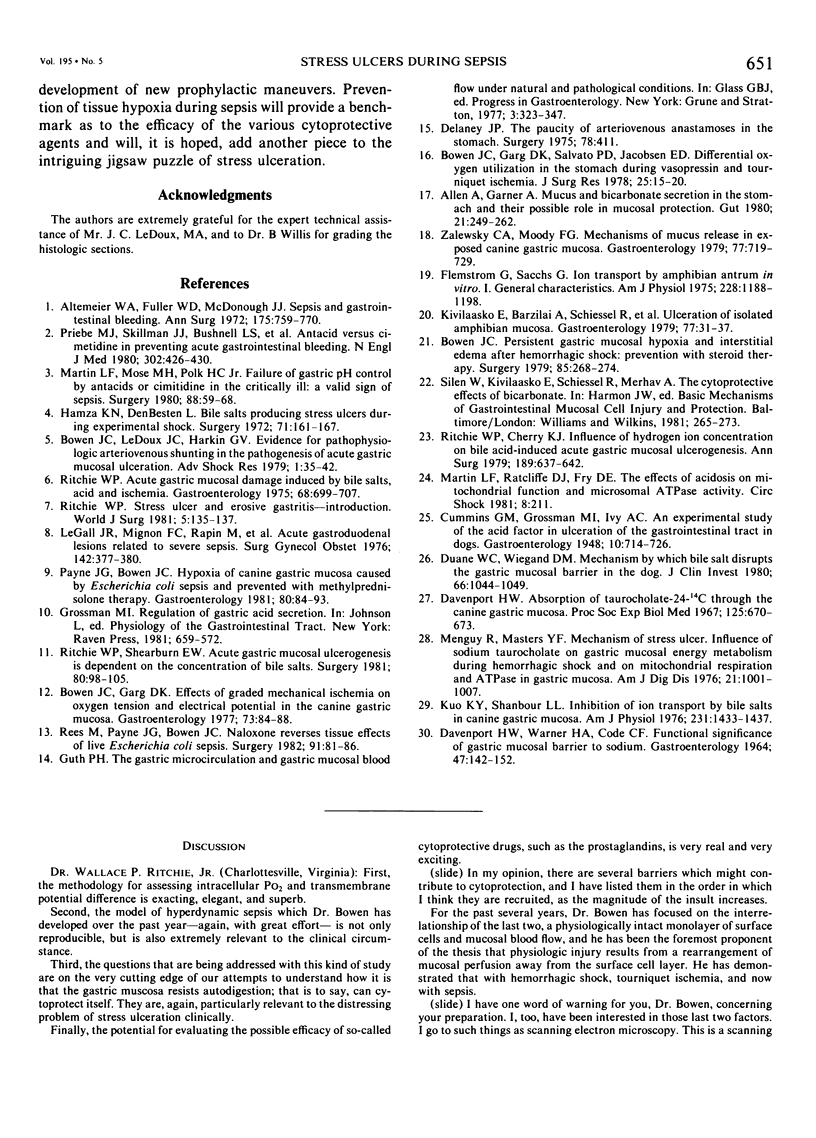
Images in this article
Selected References
These references are in PubMed. This may not be the complete list of references from this article.
- Allen A., Garner A. Mucus and bicarbonate secretion in the stomach and their possible role in mucosal protection. Gut. 1980 Mar;21(3):249–262. doi: 10.1136/gut.21.3.249. [DOI] [PMC free article] [PubMed] [Google Scholar]
- Altemeier W. A., Fullen W. D., McDonough J. J. Sepsis and gastrointestinal bleeding. Ann Surg. 1972 May;175(5):759–770. doi: 10.1097/00000658-197205000-00016. [DOI] [PMC free article] [PubMed] [Google Scholar]
- Bowen J. C., Garg D. K. Effect of graded mechanical ischemia on oxygen tension and electrical potential in the canine gastric mucosa. A new experimental model. Gastroenterology. 1977 Jul;73(1):84–88. [PubMed] [Google Scholar]
- Bowen J. C., Garg D. K., Salvato P. D., Jacobson E. D. Differential oxygen utilization in the stomach during vasopressin and tourniquet ischemia. J Surg Res. 1978 Jul;25(1):15–20. doi: 10.1016/0022-4804(78)90151-8. [DOI] [PubMed] [Google Scholar]
- Bowen J. C., LeDoux J. C., Harkin G. V. Evidence for pathophysiologic arteriovenous shunting in the pathogenesis of acute gastric mucosal ulceration. Adv Shock Res. 1978;1:35–42. [PubMed] [Google Scholar]
- Bowen J. C. Persistent gastric mucosal hypoxia and interstitial edema after hemorrhagic shock: prevention with steroid therapy. Surgery. 1979 Mar;85(3):268–274. [PubMed] [Google Scholar]
- DAVENPORT H. W., WARNER H. A., CODE C. F. FUNCTIONAL SIGNIFICANCE OF GASTRIC MUCOSAL BARRIER TO SODIUM. Gastroenterology. 1964 Aug;47:142–152. [PubMed] [Google Scholar]
- Davenport H. W. Absorption of taurocholate-24-14C through the canine gastric mucosa. Proc Soc Exp Biol Med. 1967 Jul;125(3):670–673. doi: 10.3181/00379727-125-32176. [DOI] [PubMed] [Google Scholar]
- Delaney J. P. Editorial: The paucity of arteriovenous anastomoses in the stomach. Surgery. 1975 Oct;78(4):411–413. [PubMed] [Google Scholar]
- Duane W. C., Wiegand D. M. Mechanism by which bile salt disrupts the gastric mucosal barrier in the dog. J Clin Invest. 1980 Nov;66(5):1044–1049. doi: 10.1172/JCI109932. [DOI] [PMC free article] [PubMed] [Google Scholar]
- Flemström G., Sachs T. G. Ion transport by amphibian antrum in vitro. I. General characteristics. Am J Physiol. 1975 Apr;228(4):1188–1198. doi: 10.1152/ajplegacy.1975.228.4.1188. [DOI] [PubMed] [Google Scholar]
- Hamza K. N., DenBesten L. Bile salts producing stress ulcers during experimental shock. Surgery. 1972 Feb;71(2):161–167. [PubMed] [Google Scholar]
- Kivilaakso E., Barzilai A., Schiessel R., Crass R., Silen W. Ulceration of isolated amphibian gastric mucosa. Gastroenterology. 1979 Jul;77(1):31–37. [PubMed] [Google Scholar]
- Kuo Y. J., Shanbour L. L. Inhibition of ion transport by bile salts in canine gastric mucosa. Am J Physiol. 1976 Nov;231(5 Pt 1):1433–1437. doi: 10.1152/ajplegacy.1976.231.5.1433. [DOI] [PubMed] [Google Scholar]
- Le Gall J. R., Mignon F. C., Rapin M., Redjemi M., Harari A., Bader J. P., Soussy C. J. Acute gastroduodenal lesions related to severe sepsis. Surg Gynecol Obstet. 1976 Mar;142(3):377–380. [PubMed] [Google Scholar]
- Martin L. F., Max M. H., Polk H. C., Jr Failure of gastric pH control by antacids or cimetidine in the critically ill: a valid sign of sepsis. Surgery. 1980 Jul;88(1):59–68. [PubMed] [Google Scholar]
- Menguy R., Masters Y. F. Mechanism of stress ulcer: influence of sodium taurocholate on gastric mucosal energy metabolism during hemorrhagic shock and on mitochondrial respiration and ATPase in gastric mucosa. Am J Dig Dis. 1976 Dec;21(12):1001–1007. doi: 10.1007/BF01071854. [DOI] [PubMed] [Google Scholar]
- Payne J. G., Bowen J. C. Hypoxia of canine gastric mucosa caused by Escherichia coli sepsis and prevented with methylprednisolone therapy. Gastroenterology. 1981 Jan;80(1):84–93. [PubMed] [Google Scholar]
- Priebe H. J., Skillman J. J., Bushnell L. S., Long P. C., Silen W. Antacid versus cimetidine in preventing acute gastrointestinal bleeding. A randomized trial in 75 critically ill patients. N Engl J Med. 1980 Feb 21;302(8):426–430. doi: 10.1056/NEJM198002213020802. [DOI] [PubMed] [Google Scholar]
- Rees M., Payne J. G., Bowen J. C. Naloxone reverses tissue effects of live Escherichia coli sepsis. Surgery. 1982 Jan;91(1):81–86. [PubMed] [Google Scholar]
- Ritchie W. P., Jr Acute gastric mucosal damage induced by bile salts, acid, and ischemia. Gastroenterology. 1975 Apr;68(4 Pt 1):699–707. [PubMed] [Google Scholar]
- Ritchie W. P., Jr, Cherry K. J., Jr Influence of hydrogen ion concentration on bile acid induced acute gastric mucosal ulcerogenesis. Ann Surg. 1979 May;189(5):637–642. doi: 10.1097/00000658-197905000-00014. [DOI] [PMC free article] [PubMed] [Google Scholar]
- Ritchie W. P., Jr, Shearburn E. W., 3rd Acute gastric mucosal ulcerogenesis is dependent on the concentration of bile salt. Surgery. 1976 Jul;80(1):98–105. [PubMed] [Google Scholar]
- Ritchie W. P., Jr Stress ulcer and erosive gastritis--introduction. World J Surg. 1981 Mar;5(2):135–137. doi: 10.1007/BF01658274. [DOI] [PubMed] [Google Scholar]
- Zalewsky C. A., Moody F. G. Mechanisms of mucus release in exposed canine gastric mucosa. Gastroenterology. 1979 Oct;77(4 Pt 1):719–729. [PubMed] [Google Scholar]





